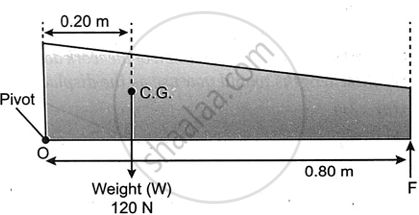Advertisements
Advertisements
प्रश्न
State the principle of moments. A meter scale is pivoted at 30 cm mark and it is in equilibrium when a mass of 40 g is suspended from 10 cm mark. Calculate the mass of the ruler.

उत्तर
Let the mass of 50 g be situated at distance 'd' from the mid-point i.e. at 50cm,
80 x 30 = (40 x 10) + (50 x d)
2400 = 400 + 50d
or 50d = 2000
or d = 40cm to the right of the mid-point.
APPEARS IN
संबंधित प्रश्न
The figure shows a uniform metre rule placed on a fulcrum at its mid-point O and having a weight 40 gf at the 10 cm mark and a weight of 20 gf at the 90 cm mark.
- Is the metre rule in equilibrium? If not how will the rule turn?
- How can the rule be brought in equilibrium by using an additional weight of 40 gf?

State the principle of moments. A meter scale is pivoted at 30 cm mark and it is in equilibrium when a mass of 40 g is suspended from 10 cm mark. Calculate the mass of the ruler.
State the principle of moments.
Explain why It is easier to knock down a boy who is standing on one foot than one who is standing on two.
What is the weight of a body placed at the centre of the earth?
A boy of mass 30 kg is fitting at a distance of 2 m from the middle of a see-saw. Where should a boy of mass 40 kg sit so as to balance the see-saw?
A ball is placed on a compressed spring. When the spring is released, the ball is observed to fly away.
(i) What form of energy does the compressed spring possess?
(ii) Why does the ball fly away?
How can we increase the stability of an object?
A non uniform beam of weight 120 N pivoted at one end is shown in the diagram below. Calculate the value of F to keep the beam in equilibrium.

